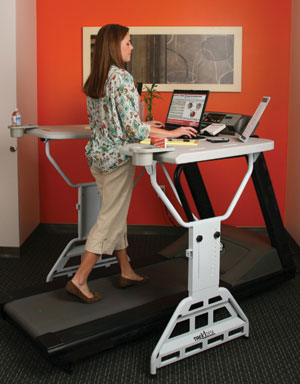Walk While You Work
A treadmill desk can help take the drudgery out of the daily grind.
We need to deliver some bad news. Are you sitting down?
Actually, that’s the problem. Studies link sitting all day on your posterior—the way you likely work every day—to numerous ailments, including cardiovascular disease, deep-vein thrombosis, diabetes, back pain and obesity. But what’s the alternative when e-mails, calls and meetings keep your nose to the grindstone and your rear in a chair?
Enter the treadmill desk. With a treadmill on the floor and a raised desk, seated tasks such as reading, typing and making phone calls become walking tasks. You avoid the health hazards of too much sitting while doubling, or even tripling, the number of calories you burn.
From just $107.88 $24.99 for Kiplinger Personal Finance
Be a smarter, better informed investor.

Sign up for Kiplinger’s Free Newsletters
Profit and prosper with the best of expert advice on investing, taxes, retirement, personal finance and more - straight to your e-mail.
Profit and prosper with the best of expert advice - straight to your e-mail.

“I feel better, have more energy, get more done at work and avoid the afternoon slump,” says Nikki Raedeke, a treadmill-desk user who is director of the dietetics program at the University of Missouri. She has also lost 20 pounds since getting the machine.
When I tried out a few treadmill desks, my perfect speed was 1.5 miles per hour. At that rate, I could type without errors and read without dizziness. The exertion left me feeling flushed—it’s a good idea to keep a water bottle on hand—but not sweaty or exhausted. My handwriting was legible but didn’t always land between the lines on my reporter’s notebook.
The most surprising discovery was how effortlessly the miles floated by. After a few phone conversations and some reading one morning, I’d logged a half-mile and burned 50 calories. Some treadmill-desk users can glide through six or seven miles before heading home for dinner.
Will your boss go along? Not all employers will agree to allocate the funds for such an unconventional way of working. And in a cubicle-intensive environment, space is an issue.
It’s easier if you have your own office, and even easier if you bring your own equipment. When Chase Poffenberger, an executive vice-president of a travel company, wanted to install a treadmill desk in her office, she got the blessing of her business partners and paid for the setup herself. She bought the TrekDesk, a $497 U-shaped steel workspace, which rests on top of an Exerpeutic treadmill she picked up for a couple hundred dollars at Target. The setup is functional, although it takes up quite a bit of space in her midsize office.
“I’d suggest buying a shared treadmill desk and see how many staff use it,” says Poffenberger. A model that’s built to stand up to the demands of the workplace costs between $1,500 and $5,000.
It couldn’t hurt to stress the benefits to your employer. (You’ll find links to dozens of articles touting the health care savings at www.trekdesk.com/costfinancial.) Plus, there may be perks that come from making your workplace healthier and fitter, including decreased absenteeism and increased productivity.
Got a home office? Using a home-gym treadmill with a separate desk is a good way to test-drive the treadmill-desk work style. But if you decide to buy in for the long haul, you’re better off with a dedicated model. Regular treadmills are built for shorter bursts of activity, while office treadmills are designed for the long, slow grind.
One relatively affordable option is LifeSpan’s TR1200-DT5 treadmill desk, which costs $1,500 for the whole package. The rectangular desktop and handrail-free treadmill look sleek and professional. The console displays on the inside of the desk show time, distance, calories and steps taken. That means no reaching over your computer to check your mileage or adjust the speed.
You’ll save money if you supply your own desk, perhaps modifying one you already have. For example, the LifeSpan TR800-DT3 treadmill, which is designed for three hours of use per day, comes without a desk and retails for $800. It has an easy-to-see display console that sits on your desktop.
Standing desks. Poffenberger’s treadmill desk has inspired her space-deprived, cubicle-bound co-workers to start using standing desks. Standing desks help combat the health hazards of sitting for less than the investment in a treadmill desk. Poffenberger’s company pays for workstation modifications, such as raised keyboard trays and adjustable monitor mounts, that can be used with a standing desk.
There are dozens of options, from the non-height-adjustable Altra Bobbi Standing Craft Desk ($130 at Staples) to Steelcase’s $1,400 Airtouch desk, which goes from sitting to standing height in one second. The hands-down cheapest option is rigging up your own. Search “DIY standing desk” online and on YouTube for tutorials using everything from Ikea parts to PVC piping and furniture crates.
An anti-fatigue mat to accompany a standing desk will help keep your feet and legs feeling fresh. They sell for as little as $20 at Home Depot.
Profit and prosper with the best of Kiplinger's advice on investing, taxes, retirement, personal finance and much more. Delivered daily. Enter your email in the box and click Sign Me Up.
Susannah Snider worked as a research-reporter and staff writer at Kiplinger Personal Finance Magazine. She went on to serve as managing editor for money at U.S. News, overseeing articles and content covering real estate, personal finance and careers. She is a certified financial planner professional and earned her CFP marks in 2019.
-
 Dave Ramsey Tells Us the Biggest Retirement Mistake You Can Make
Dave Ramsey Tells Us the Biggest Retirement Mistake You Can MakeThe talk-show host, author and podcaster tells Kiplinger what people can do to ensure a happy retirement.
-
 Pros and Cons of Alternative Assets in Workplace Retirement Plans
Pros and Cons of Alternative Assets in Workplace Retirement PlansWhile alternatives offer diversification and higher potential returns, including them in your workplace retirement plan would require careful consideration.
-
 Amazon Resale: Where Amazon Prime Returns Become Your Online Bargains
Amazon Resale: Where Amazon Prime Returns Become Your Online BargainsFeature Amazon Resale products may have some imperfections, but that often leads to wildly discounted prices.
-
 Roth IRA Contribution Limits for 2025
Roth IRA Contribution Limits for 2025Roth IRAs Roth IRAs allow you to fund your retirement with after-tax dollars while you're working, and then withdraw those contributions and earnings tax-free when you retire. Here's a look at 2025 limits and income-based phaseouts.
-
 How to Search For Foreclosures Near You: Best Websites for Listings
How to Search For Foreclosures Near You: Best Websites for ListingsMaking Your Money Last Searching for a foreclosed home? These top-rated foreclosure websites — including free, paid and government options — can help you find listings near you.
-
 Four Tips for Renting Out Your Home on Airbnb
Four Tips for Renting Out Your Home on Airbnbreal estate Here's what you should know before listing your home on Airbnb.
-
 Five Ways to a Cheap Last-Minute Vacation
Five Ways to a Cheap Last-Minute VacationTravel It is possible to pull off a cheap last-minute vacation. Here are some tips to make it happen.
-
 How Much Life Insurance Do You Need?
How Much Life Insurance Do You Need?insurance When assessing how much life insurance you need, take a systematic approach instead of relying on rules of thumb.
-
 When Does Amazon Prime Day End in October? Everything We Know, Plus the Best Deals on Samsonite, Samsung and More
When Does Amazon Prime Day End in October? Everything We Know, Plus the Best Deals on Samsonite, Samsung and MoreAmazon Prime The Amazon Prime Big Deal Days sale ends soon. Here are the key details you need to know, plus some of our favorite deals members can shop before it's over.
-
 How to Shop for Life Insurance in 3 Easy Steps
How to Shop for Life Insurance in 3 Easy Stepsinsurance Shopping for life insurance? You may be able to estimate how much you need online, but that's just the start of your search.